생후 4∼5개월 영아에게 모유, 인공영양, 이유식 먹이기, Breastfeeding, formula feeding, and solid food feeding for 4-5 months infants
| 생후 4개월 한국 영아들의 성장 |
표 3-4. 생후 4개월 된 한국 영아들의 체중과 신장의 백분위수
| 성별
백분위수 |
3 | 10 | 25 | 50 | 75 | 90 | 97 | |
| 남아 | 체중(kg) | 5.70 | 6.20 | 6.80 | 7.30 | 8.00 | 8.70 | 9.40 |
| 신장(cm) | 59.0 | 61.0 | 63.0 | 64.6 | 66.2 | 68.2 | 70.1 | |
| 여아 | 체중(kg) | 5.10 | 5.90 | 6.40 | 6/86 | 7/30 | 8.20 | 9.10 |
| 신장(cm) | 58.0 | 60.0 | 61.6 | 63.2 | 65.0 | 67.4 | 69.3 |
표 3-5. 5개월 한국 영아들의 체중과 신장의 백분위 수
| 성별
백분위 수 |
3 | 10 | 25 | 50 | 75 | 90 | 97 | |
| 남아 | 체중(kg) | 6.0 | 6.50 | 7.09 | 7.73 | 8.35 | 9.00 | 9.60 |
| 신장(cm) | 59.9 | 62.0 | 64.0 | 66.0 | 68.0 | 69.7 | 72.0 | |
| 여아 | 체중(kg) | 5.45 | 6.00 | 6.60 | 7.23 | 8.00 | 8.50 | 9.39 |
| 신장(cm) | 59.0 | 61.4 | 63.0 | 65.0 | 67.9 | 68.6 | 72.0 |
소스: 부모도 반의사가 되어야 한다―소아가정간호백과
| 모유수유 |
- 생후 4~5개월 동안 대부분의 영아들은 어마의 젖만 먹어도 정상적으로 잘 성장 발육할 수 있다.
- 모유만 먹는 영아들에게는 철분제와 비타민 A, C, D가 든 종합 비타민제 드롭(점적약제)을 의사 처방에 따라 먹일 수 있다.
- 비타민 A, C, D 점적약제 외 더 많은 종류의 비타민제와 철분제가 든 종합 비타민제 점적약제도 처방에 따라 먹일 수 있다.
- 일반적으로 철분제만 따로 먹일 필요는 없다.
- 하루에 5∼6번 정도 모유를 수유 할 수 있다.
- 밤에 한번 잠들면 아침까지 한 번도 깨지 않고 계속 자고 엄마 아빠와 같이 아침에 일어나는 영아들도 있다.
- 곤히 잠자는 영아를 밤중에 일부러 깨워 모유를 꼭 수유할 필요가 없다.
- 생후부터 지금까지 모유가 충분히 분비되면 모유수유만 해도 잘 성장 발육할 수 있다. 생후 4개월부터 이유식(Solid foods)을 먹이기 시작할 수 있으나 이 시기에 모유수유를 하면서 이유식을 꼭 먹일 필요 없다.
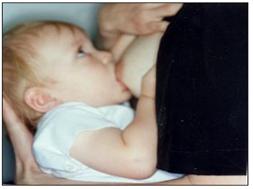
사진 4-24. 모유수유를 할 때 젖 먹는 아기와 눈을 맞추면서 수유해야 한다.
Copyright ⓒ 2011 John Sangwon Lee, MD., FAAP
| Bisphenol A(BPA)는 내분비 기능을 교란시키는 역할을 하는 화학물이다. 최근 Allen Foundation 연구에 의하면 캔푸드를 많이 섭취하는 사람들의 소변 검사에 상당히 높은 BPA 농도가 발견됐다. 체 내 BPA의 농도가 높으면 심장 혈관 병, 당뇨병, 비정상 간 효소 농도 증가 생기고 임신부의 경우 태어난 신생아에게도 건강 문제가 생긴다고 한다. 이런 이유로 손끝으로 요리한 엄마의 사랑 음식물을 즐거히 먹어야 건강에 더 좋다는 말이 참말이다. (11월 25, 2011). |
| 생후 4~5개월 동안 인공영양 먹이기 |
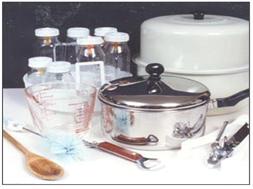
사진 4-25. 인공영양을 먹이는데 필요한 것들
Copyright ⓒ 2011 John Sangwon Lee, MD., FAAP
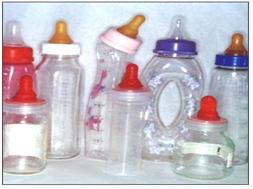
사진 4-26. 인공영양을 먹이는데 필요한 여러 종류 우유병들
Copyright ⓒ 2011 John Sangwon Lee, MD., FAAP
- 모유만 수유해 양육 하는 것이 아기에게 가장 좋다. 그러니 모유만 수유하는 대신 인공영양(Formula)으로 아주 바꿔 먹이는 경우와 모유수유도 하고 거기다가 인공영양을 보충으로 더 먹이는 경우 아기의 성장 발육, 육아에 어떤 영향을 끼칠 수 있나 참고 할 수 있는 정보를 여기서 제공한다.
- 인공영양의 종류, 1회 먹일 수 있는 인공영양의 양, 온도, 하루 먹이는 횟수, 먹이는 간격 등을 일률적으로 정할 수 없다.
- 다음에 일반적 인공영양을 먹이는 방법을 간단히 설명한다.
- 생후 4~5개월 영아들에게 인공영양 만 먹일 때 인공영양 1회분은 150∼240cc(5∼8온스) 정도이다. 그 1회분을 하루 4∼6회 정도 먹인다.
- 영아들에게 필요로 하는 각종 비타민 성분이 인공영양 성분 속에 적절히 들어 있다.
- 그래서 인공영양을 먹는 아기에게 비타민제를 따로 더 먹일 필요가 없다.
- 이때부터 우유병과 우유병 꼭지를 더 이상 끓여 멸균시킬 필요가 없다. (부모도 반의사가 되어야 한다―소아가정간호백과-제 5권 인공영양, 우유, 이유, 비타민, 미네랄, 단백질 탄수화물, 지방 참조)
| 생후 4~5개월 동안 물이나 수분을 꼭 더 먹여야 하나 |
- 인공영양 성분의 85%정도가 수분이다. 모유 성분의 수분 양은 인공영양 성분의 수분의 양과 거의 같다. 그래서 모유수유를 할 때나 인공영양을 먹일 때 물을 따로 더 먹일 필요가 없다.
- 더운 여름철이나 실내가 덥거나 아기가 땀을 많이 흘리거나 무슨 이유로 탈수가 된 것 같으면 끓여 식힌 맹물이나 보리차 물 등을 수저로 떠먹이든지 젖병으로 가끔 먹여도 된다.
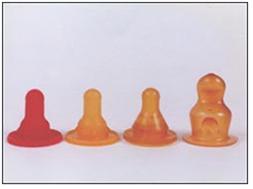
사진 3-42. 여러 종류의 인공영양 병(젖병/우유병) 꼭지
Copyright ⓒ 2011 John Sangwon Lee, MD., FAAP
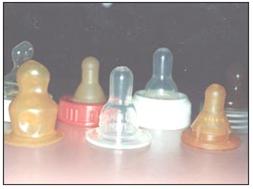
사진 3-43. 여러 종류의 인공영양 병(젖병/우유병) 꼭지
Copyright ⓒ 2011 John Sangwon Lee, MD., FAAP
| 생후 4~5개월 동안 젖 먹는 아기에게 이유식을 먹어야 하나 |
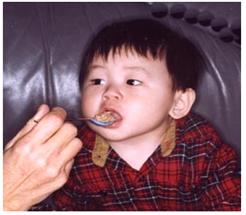
사진 3-44. 이유식은 수저나 컵으로 먹인다.
Copyright ⓒ 2011 John Sangwon Lee, MD., FAAP
- 인공영양이나 모유를 충분히 먹고 정상적으로 잘 성장 발육하고 있는 4~5개월 영아들에게는 이유식을 꼭 먹일 필요 없다. 참고로 이유식을 solid foods 또는 Weaning foods라고 합니다.
- 인공영양이나 모유만 먹고 자주 배고파 울거나, 밤에 자다가 배고파서 자주 깨거나, 인공영양이나 모유수유로 영양분이나 칼로리를 충분히 섭취할 수 없는 것 같거나, 잘 성장하지 않는 것 같거나, 모유가 충분히 분비되지 않는다고 생각될 때는 의사와 상담한 후 시리얼류 이유식(곡분류 이유식)을 먹이기 시작해도 된다.
- 이유식을 먹이기 시작할 때는 쌀로 만든 곡분류 이유식을 맨 먼저 먹이기 시작하는 것이 좋다. 한 수저 정도 곡분류 이유식을 짠 모유나 인공영양 또는 물에 섞어 수저로 떠먹일 수 있다.
- 그 다음부터 이런 곡분류 이유식을 하루 1∼4번 정도, 약 3∼7일간 시험 삼아 먹여보고 그 곡분류 이유식을 좋아서 잘 받아먹고 그 이유식을 먹은 후 잘 소화시키고 설사하지 않고 위장장애가 생기지 않고 알레르기가 생기지 않으면 그 후 그 곡분류 이유식을 계속 먹일 수 있다.
- 마지막으로 그 이유식이 아기에게 적절한 이유식이라고 판단하면 그 이유식의 양을 점점 더 증가해서 계속 먹일 수 있다.
- 사과나 그 외 다른 과일로 만든 과일류 이유식, 호박이라 당근 등으로 만든 채소류 이유식, 과일 주스류 이유식은 될 수 있는 한 생후 6개월 이전에는 먹이지 않는다.
- 미 소아청소년과 학회는 생후 6개월 이전에는 과일류 이유식과 채소류 이유식을 권장하지 않는다.
- 과일 주스류 이유식이나 채소 주스류 이유식은 생후 6개월 이전 먹이지 말고 그 이후 영아들에게 도 델 수 있는 한 많이 먹이지 말아야 한다.
- 쇠고기, 양고기, 또는 닭고기 등의 육류 이유식이나 생선 이유식은 생후 9~10개월부터 먹이기 시작할 수 있다.
- 그 중 한 종류의 육류 이유식을 선택해서 시험 삼아 조금씩 먹여 보고 아기가 먹기를 좋아하고 잘 소화시키고 알레르기 반응이 생기지 않으면 의사의 지시에 따라 육류 이유식도 계속 먹일 수 있다.
- 이유식을 처음 먹일 때는 한 종류의 이유식을 시험 삼아 적어도 1주일 정도 계속 먹여보고 그 이유식을 먹고 문제가 없으면 그 다음에는 두 가지, 또 그 다음에는 세 가지, 또 그 이상 여러 가지의 이유식 성분이 섞인 종합 이유식을 먹일 수 있다.
- 이유식을 먹고 소화를 잘 시키면 그 이유식을 하루 1∼4번 정도 먹일 수 있고 성장 발육의 정도와 먹성에 따라 이유식의 양을 점차로 증가시킨다.
- 이유식을 먹이기 시작할 때 처음부터 “많이 주면 좋다”라고 생각해 한꺼번에 너무 많이 먹여서는 안 된다. 처음부터 적게 먹이기 시작하고 점차로 양을 늘리는 편이 훨씬 좋다.
- 하루 중 이유식을 먹이는 시간을 일률적으로 정할 수 없다. 엄마 아빠의 일상생활 패턴 리듬에 맞춰 모유나 인공영양을 먹인 후 바로 이유식을 먹이든지, 모유나 인공영양을 먹일 시간에 모유나 인공영양을 먹이는 대신 이유식만 먹이든지, 모유나 인공영양을 먹이기 바로 전에 이유식을 먹이든지, 또는 모유나 인공영양을 먹는 시간 사이사이에 먹일 수 있다. 주스류 이유식을 처음 먹일 때 한 번에 한 종류의 주스 이유식의 15∼30cc 정도 먹여 볼 수 있다.
- 곡분류 이유식이나 육류 이유식을 처음 먹일 때는 곡분류 이유식이나 육류 이유식을 한 테이블스푼 분량(15㏄) 정도 먹여본다.
- 달걀 전체나 전 우유는 생후 12개월까지 먹이지 말아야 한다.
- 달걀노른자는 생후 6개월부터 먹일 수 있다. 그러나 아토피 체질이 있거나 부모형제 자매들에게 알레르기 질환이 있는 가족 병력이 있는 아기들에게는 될 수 있으면 달걀노른자도 2세 이전에 먹이지 않는 것이 좋다.
- 주스류 이유식이나 과일즙류 이유식은 이유 연습용 컵으로 먹이든지 수저로 떠먹이는 것이 좋다.
- 곡분류 이유식이나 육류 이유식을 우유병에 넣어 먹여서는 안 된다.
- 이유식을 먹일 때 이유식 1회분 양이나, 또는 1일분 양을 잘 조절해서 먹여야 한다.
- 이유식을 한 번에 너무 많이 먹이거나 너무 자주 먹이면 소화 장애가 생길 수 있다.
- 또 영아들에게 이유식을 너무 많이 먹이면 비만해질 수 있다.
- 사실은 대부분의 영아들이 모유나 인공영양을 충분히 먹으면 생후 6개월 이전 이유식을 조금도 먹지 않고서도 잘 성장 발육할 수 있다.
- 다시 한 번 더 강조하면, 이유식은 시험 삼아 한 종류의 이유식을 조금씩 먹이기 시작하고 점차로 그 양과 종류를 늘려 먹여야 한다. (부모도 반의사가 되어야 한다―소아가정간호백과-제 3권 신생아, 영유아, 학령기아, 사춘기아 성장 발육 육아, 제22권 아들 딸 이렇게 사랑해 키우세요-이유식을 참조)

사진 4-31. 스스로 이유식을 손으로 먹게 한다. 이런 방법으로 독립심을 길러준다.
Copyright ⓒ 2011 John Sangwon Lee, MD., FAAP

사진 4-25. 승용차를 타고 영유아를 데리고 어디를 갈 때는 국법으로 허가된 안전 의자에 앉히고 차를 몬다. 이것은 법이다.
Copyright ⓒ 2011 John Sangwon Lee, MD., FAAP
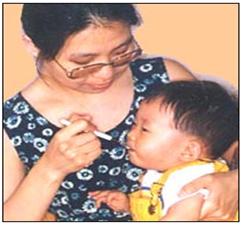
사진 4-26. 이유식은 수저로 떠먹이든지.
Copyright ⓒ 2011 John Sangwon Lee, MD., FAAP
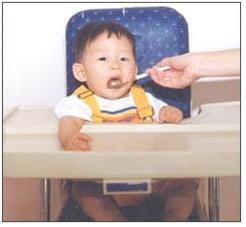
▴ 사진 4-27. 이유식은 수저로 떠먹이든 지.
Copyright ⓒ 2011 John Sangwon Lee, MD., FAAP
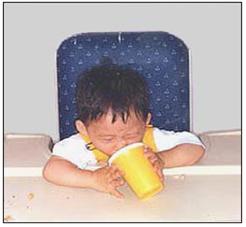
사진 4-28. 물이나 액체 이유식은 컵으로 먹인다.
Copyright ⓒ 2011 John Sangwon Lee, MD., FAAP
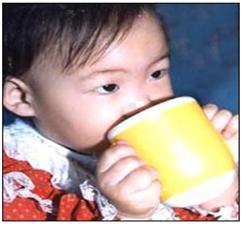
사진 4-29. 액체 이유식은 스스로 컵으로 마시게 한다.
Copyright ⓒ 2011 John Sangwon Lee, MD., FAAP
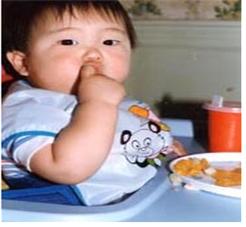
사진 4-30. 스스로 이유식을 손으로 먹게 한다.
Copyright ⓒ 2011 John Sangwon Lee, MD., FAAP
Breastfeeding, formula feeding, and solid food feeding for 4-5 months infants 생후 4∼5개월 영아에게 모유, 인공영양, 이유식 먹이기
| Growth of Korean infants at 4 months of age |
Table 3-4. Percentiles of weight and height in Korean infants at 4 months of age 표 3-4. 생후 4개월 된 한국 영아들의 체중과 신장의 백분위수
| Gender /Percentile | 3 | 10 | 25 | 50 | 75 | 90 | 97 | |
| Boys | weight(kg) | 5.70 | 6.20 | 6.80 | 7.30 | 8.00 | 8.70 | 9.40 |
| Height(cm) | 59.0 | 61.0 | 63.0 | 64.6 | 66.2 | 68.2 | 70.1 | |
| Girls | weight(kg) | 5.10 | 5.90 | 6.40 | 6/86 | 7/30 | 8.20 | 9.10 |
| Height(cm) | 58.0 | 60.0 | 61.6 | 63.2 | 65.0 | 67.4 | 69.3 |
Table 3-5. Percentiles of weight and height of 5-month 표 3-5. 5개월 한국 영아들의 체중과 신장의 백분위 수
| Gender /Percentile | 3 | 10 | 25 | 50 | 75 | 90 | 97 | |
| Boys | weight(kg) | 6.0 | 6.50 | 7.09 | 7.73 | 8.35 | 9.00 | 9.60 |
| Height (cm) | 59.9 | 62.0 | 64.0 | 66.0 | 68.0 | 69.7 | 72.0 | |
| Girls | weight(kg) | 5.45 | 6.00 | 6.60 | 7.23 | 8.00 | 8.50 | 9.39 |
| Height (cm) | 59.0 | 61.4 | 63.0 | 65.0 | 67.9 | 68.6 | 72.0 |
Source: Parents should also be at least the half-doctors-Pediatric Family Nursing Encyclopedia Breastfeeding During the first 4 to 5 months of age, most infants can grow and develop normally by eating only breast milk.
Infants who eat only breast milk can be fed iron and multivitamin drops containing vitamins A, C, and D as prescribed by a doctor.
In addition to vitamin A, C, D drops, many more types of vitamins and multivitamin drops containing iron can also be fed according to the prescription.
In general, it is not necessary to feed only iron.
You can breastfeed 5-6 times a day. When they fall asleep once at night, there are infants who do not wake up until morning and continue to sleep and wake up in the morning with their mother and father.
Infants who sleep well are deliberately awakened at night so that they do not need to breastfeed.
If enough breast milk is secreted from birth until now, it can grow and develop well just by breastfeeding.
You can start feeding solid foods from 4 months of age, but you do not need to feed baby food while breastfeeding at this time.

Photo 4-24. When breastfeeding, you need to make eye contact with the baby you are breastfeeding. Copyright ⓒ 2011 John Sangwon Lee, MD., FAAP
| Bisphenol A (BPA) is a compound that plays a role in disrupting the function of the endocrine system.
A recent Allen Foundation study found significantly higher levels of BPA in urine tests in people who ate a lot of canned food. High levels of BPA in the body lead to increased levels of cardiovascular disease, diabetes, and abnormal liver enzymes. For this reason, it is true that it is better for her health to enjoy her mother’s love food cooked with her fingertips. (November 25, 2011). |
Feeding artificial nutrition for 4-5 months of age

Photo 4-25. What you need to feed artificial nutrition. Copyright ⓒ 2011 John Sangwon Lee, MD., FAAP

Photo 4-26. Different types of milk bottles needed to feed artificial nutrition. Copyright ⓒ 2011 John Sangwon Lee, MD., FAAP
Breastfeeding and nurturing are best for your baby.
Therefore, if you switch to artificial nutrition (Formula) instead of breastfeeding only, and if you also breastfeed and supplement artificial nutrition, you can refer to information that can affect the growth and development of the baby and child-rearing.
Provided here. The type of artificial nutrition, the amount of artificial nutrition that can be fed once, the temperature, the number of feedings per day, and the feeding interval cannot be uniformly determined.
Next, we will briefly explain how to feed general artificial nutrition.
When feeding only artificial nutrition to infants 4-5 months of age, one serving of artificial nutrition is about 150-240cc (5-8 ounces).
One serving is fed 4-6 times a day.
Various vitamins required by infants are properly contained in artificial nutritional ingredients.
So, you don’t need to take extra vitamins for babies who eat artificial nutrition.
From this point on, it is no longer necessary to boil and sterilize the milk bottle and the bottle cap. (Parents should also be at least the half-doctors-Refer to Encyclopedia of Child and Family Nursing-Volume 5 artificial nutrition, milk, weaning, vitamins, minerals, protein carbohydrates, fat)
Should newborns drink more water or moisture for 4-5 months of age?
About 85% of artificial nutrients are moisture.
The amount of moisture in the breast milk component is almost the same as the amount of moisture in the artificial nutritional component.
So, when breastfeeding or feeding artificial nutrition, there is no need to additionally water. In the hot summer months, if the room is hot, the baby is sweating a lot, or if you feel dehydrated for some reason, you can feed boiled cold water or barley tea with a spoon or feed it occasionally with a baby bottle.

Photo 3-42. Different types of artificial nutrition bottles (baby bottles/milk bottles) nipples. Copyright ⓒ 2011 John Sangwon Lee, MD., FAAP

Photo 3-43. Different types of artificial nutrition bottles (baby bottles/milk bottles) nipples. Copyright ⓒ 2011 John Sangwon Lee, MD., FAAP
Should I eat baby food for babies who are breastfeeding for 4-5 months of age?

Photo 3-44. Baby food is fed with a spoon or cup. Copyright ⓒ 2011 John Sangwon Lee, MD., FAAP
Infants from 4 to 5 months old who eat enough artificial nutrition or breast milk and are growing and developing normally do not need to feed baby food.
For reference, baby food is called solid foods or Weaning foods.
Eating only artificial nutrition or breast milk, crying often hungry, sleeping at night and waking up often due to hunger, not being able to consume enough nutrients or calories due to artificial nutrition or breastfeeding, not growing well, or secreting enough breast milk If you don’t think it’s possible, you can start feeding cereal baby food (grain type baby food) after consulting your doctor.
When you start feeding baby food, it’s best to start feeding grain-type baby food made from rice first.
About one spoonful of grain sorting baby food can be fed with a spoonful of squeezed breast milk, artificial nutrition, or mixed with water.
From then on, try eating this type of cereal for a test about 1 to 4 times a day, about 3 to 7 days, and eat it well because you like the type of baby food.
If it does not occur, you can continue to feed the grain type baby food after that. Finally, if you determine that the baby food is appropriate for your baby, you can continue to feed the baby food more and more.
Fruit baby food made with apples or other fruits, vegetable baby food made with carrots because pumpkin, fruit juice baby food should not be fed before 6 months of age as much as possible.
The American Academy of Pediatrics and Adolescents does not recommend fruit foods and vegetable foods before 6 months of age.
Fruit juice baby food or vegetable juice baby food should not be fed before 6 months of age and should not be fed to infants after that as much as possible.
Meat baby food such as beef, lamb, or chicken or fish baby food can be fed from 9 to 10 months of age.
Select one type of meat baby food as a test feeding and feed it little by little. If the baby likes to eat and digests well and does not develop an allergic reaction, you can continue to feed the meat baby food according to the doctor’s instructions.
When feeding baby food for the first time, take one type of baby food as a test and continue to feed it for at least a week, and if there is no problem after eating the baby food, then two, and then three, and more than one type of baby food ingredients are mixed together.
You can feed baby food. If you eat baby food and digest it well, you can feed the baby food 1 to 4 times a day, and gradually increase the amount of baby food depending on the degree of growth and development and eatability.
When you start feeding baby food, they shouldn’t eat too much at once by thinking “it’s good to give it a lot” from the beginning.
It is much better to start feeding less from the beginning and gradually increase the amount.
You cannot uniformly determine the time of day to feed baby food.
Either feed the baby food immediately after feeding breast milk or artificial nutrition in accordance with the rhythm of the daily life patterns of mothers and fathers, feed only baby food instead of breast milk or artificial nutrition at the time of feeding, or just before feeding breast milk or artificial nutrition. It can be fed with baby food, or between breast milk or artificial nutrition.
When feeding juice baby food for the first time, you can see about 15-30cc of one kind of juice baby food at a time.
When you first feed grain-type baby food or meat baby food, try feeding about one tablespoon (15㏄) of grain-type baby food or meat baby food.
Whole eggs or whole milk should not be fed until 12 months of age.
Egg yolk can be fed from 6 months of age.
However, for babies with the atopic constitution or a family history of allergic diseases to their parents, siblings, it is better not to feed egg yolks before 2 years of age, if possible. Juice-type baby food or fruit juice-type baby food is recommended to be fed with a weaning training cup or with a spoon.
Grain-based baby food or meat baby food should not be fed in a milk bottle. When feeding baby food, the amount of one serving of baby food or the amount of one serving per day should be well controlled and fed.
Eating too much baby food at a time or too often can cause digestive problems. Also, feeding too much baby food to infants can lead to obesity.
In fact, if most infants eat enough breast milk or artificial nutrition, they can grow and develop well without eating any baby food before 6 months of age.
Once again, we should start feeding one type of baby food little by little as a test for baby food, and gradually increase the amount and type. (Parents should also become at least the half-doctors-Encyclopedia of Child and Family Nursing-Volume 3 Newborns, Infants, School Age Hunger, Adolescents, Growth and Development, Vol. 22, Sons and Daughters Love and Raise-Refer to weaning foods)

Photo 4-31. Have them eat baby food with their own hands. In this way, it fosters independence. Copyright ⓒ 2011 John Sangwon Lee, MD., FAAP

Photo 4-25. When going anywhere in a car with infants and toddlers, sit in a safety chair licensed under the national law and drive the car. This is the law. Copyright ⓒ 2011 John Sangwon Lee, MD., FAAP

Photo 4-26. Either he eats baby food with a spoon. Copyright ⓒ 2011 John Sangwon Lee, MD., FAAP

▴ Photo 4-27. He can eat baby food with a spoon. Copyright ⓒ 2011 John Sangwon Lee, MD., FAAP

Photo 4-28. Water or liquid baby food is fed with a cup. Copyright ⓒ 2011 John Sangwon Lee, MD., FAAP

Photo 4-29. Liquid baby food allows him to drink his own cup. Copyright ⓒ 2011 John Sangwon Lee, MD., FAAP

Photo 4-30. Have them eat baby food with their own hands. Copyright ⓒ 2011 John Sangwon Lee, MD., FAAP
출처 및 참조 문헌
- NelsonTextbook of Pediatrics 22ND Ed
- The Harriet Lane Handbook 22ND Ed
- Growth and development of the children
- Red Book 32nd Ed 2021-2024
- www.drleepediatrics.com 제1권 소아청소년 응급 의료
- www.drleepediatrics.com 제2권 소아청소년 예방
- www.drleepediatrics.com 제3권 소아청소년 성장 발육 육아
- www.drleepediatrics.com 제4권 모유,모유수유, 이유
- www.drleepediatrics.com 제5권 인공영양, 우유, 이유식, 비타민, 미네랄, 단백질, 탄수화물, 지방
- www.drleepediatrics.com 제6권 신생아 성장 발육 육아 질병
- www.drleepediatrics.com제7권 소아청소년 감염병
- www.drleepediatrics.com제8권 소아청소년 호흡기 질환
- www.drleepediatrics.com제9권 소아청소년 소화기 질환
- www.drleepediatrics.com제10권. 소아청소년 신장 비뇨 생식기 질환
- www.drleepediatrics.com제11권. 소아청소년 심장 혈관계 질환
- www.drleepediatrics.com제12권. 소아청소년 신경 정신 질환, 행동 수면 문제
- www.drleepediatrics.com제13권. 소아청소년 혈액, 림프, 종양 질환
- www.drleepediatrics.com제14권. 소아청소년 내분비, 유전, 염색체, 대사, 희귀병
- www.drleepediatrics.com제15권. 소아청소년 알레르기, 자가 면역질환
- www.drleepediatrics.com제16권. 소아청소년 정형외과 질환
- www.drleepediatrics.com제17권. 소아청소년 피부 질환
- www.drleepediatrics.com제18권. 소아청소년 이비인후(귀 코 인두 후두) 질환
- www.drleepediatrics.com제19권. 소아청소년 안과 (눈)질환
- www.drleepediatrics.com 제20권 소아청소년 이 (치아)질환
- www.drleepediatrics.com 제21권 소아청소년 가정 학교 간호
- www.drleepediatrics.com 제22권 아들 딸 이렇게 사랑해 키우세요
- www.drleepediatrics.com 제23권 사춘기 아이들의 성장 발육 질병
- www.drleepediatrics.com 제24권 소아청소년 성교육
- www.drleepediatrics.com 제25권 임신, 분만, 출산, 신생아 돌보기
- Red book 29th-31st edition 2021
- Nelson Text Book of Pediatrics 19th- 21st Edition
- The Johns Hopkins Hospital, The Harriet Lane Handbook, 22nd edition
- 응급환자관리 정담미디어
-
소아가정간호백과–부모도 반의사가 되어야 한다, 이상원
-
Neonatal Resuscitation American heart Association
-
Neonatology Jeffrey J.Pomerance, C. Joan Richardson
-
Pediatric Resuscitation Pediatric Clinics of North America, Stephen M. Schexnayder, M.D.
-
Pediatric Critical Care, Pediatric Clinics of North America, James P. Orlowski, M.D.
-
Preparation for Birth. Beverly Savage and Dianna Smith
-
Infectious disease of children, Saul Krugman, Samuel L Katz, Ann A. Gershon, Catherine Wilfert
- Pediatric Nutritional Handbook American Academy of Pediatrics
- 소아가정간호백과–부모도 반의사가 되어야 한다, 이상원
- The pregnancy Bible. By Joan stone, MD. Keith Eddleman, MD
- Neonatology Jeffrey J. Pomerance, C. Joan Richardson
- Preparation for Birth. Beverly Savage and Dianna Smith
- 임신에서 신생아 돌보기까지. 이상원
- Breastfeeding by Ruth Lawrence and Robert Lawrence
- Infectious disease of children, Saul Krugman, Samuel L Katz, Ann A. Gershon, Catherine Wilfert
- The Harriet Lane Handbook 19th Edition
- 제4권 모유, 모유수유, 이유 참조문헌 및 출처
- 제5권 인공영양, 우유, 이유, 비타민, 단백질, 지방 탄수 화물 참조문헌 및 출처
- 제6권 신생아 성장발육 양호 질병 참조문헌 및 출처
- 소아과학 대한교과서
- 그 외
-
Copyright ⓒ 2015 John Sangwon Lee, MD., FAAP
미국 소아과 전문의, 한국 소아청소년과 전문의 이상원 저 “부모도 반의사가 되어야 한다”-내용은 여러분들의 의사로부터 얻은 정보와 진료를 대신할 수 없습니다.
“The information contained in this publication should not be used as a substitute for the medical care and advice of your doctor. There may be variations in treatment that your doctor may recommend based on individual facts and circumstances. “Parental education is the best medicine.”